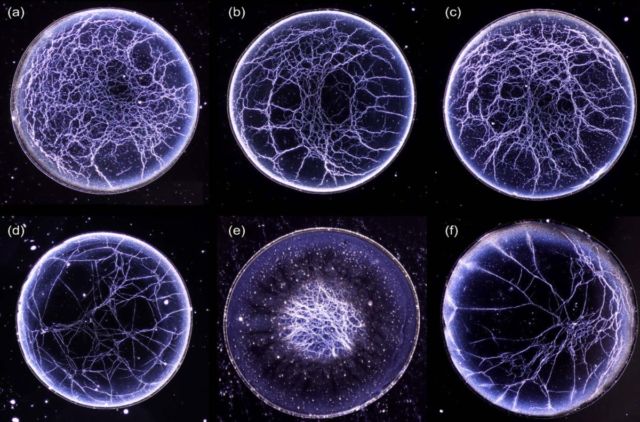American whiskeys leave behind a web-like “fingerprint” as they evaporate
It’s possible to tell the difference between an American whiskey and other whiskeys just by studying the residual patterns left behind by the American variety as it evaporates, according to a new paper in Physical Review Fluids. Liquors like Scotch whisky, moonshine, and Irish whiskeys don’t leave these telltale patterns, or “whiskey webs,” when they evaporate.
As any connoisseur could tell you, the difference between Scotch whisky and American whiskey is more than just a single letter. “Scotch whisky typically acquires its flavor while it ages in mature—often recycled—barrels, while American whiskey, such as bourbon, is aged in new, charred-oak barrels,” Matteo Rini wrote at APS Physics. “Understanding what this means at the chemical level could help with spotting illegal counterfeits and suggest faster alternatives to traditional aging.” (Corn whiskey is an exception among the American varieties; it does not require wood aging at all.)
Co-author Stuart Williams, a professor of mechanical engineering at the University of Louisville in Kentucky, noticed one day that if he diluted a drop of bourbon and let it evaporate under carefully controlled conditions, it formed what he terms a “whiskey web”: thin strands that form various lattice-like patterns, akin to networks of blood vessels. Intrigued, he decided to investigate further with different types of whiskey—plus a bottle of Glenlivet Scotch whisky for comparison. It was the perfect project for his sabbatical leave to study colloids (suspended particles in a medium, like Jell-O, whipped cream, tea, wine, and whiskey) at North Carolina State University.

Williams was also inspired in part by an earlier collaboration between Princeton University physicist Howard Stone and a Phoenix-based photographer named Ernie Button. Button’s wife loved her whisky, so he began taking photographs of the intricate patterns that formed on the bottom of the glass as the liquid evaporated. Fundamentally, it’s the same underling mechanism as the “coffee ring effect,” when a single liquid evaporates and the solids that had been dissolved in the liquid (like coffee grounds) form a telltale ring. It happens because the evaporation occurs faster at the edge than at the center. Any remaining liquid flows outward to the edge to fill in the gaps, dragging those solids with it.
Mixing in solvents (water or alcohol) reduces the effect, as long as the drops are very small. Large drops produce more uniform stains. When Stone tracked the fluid motion in whiskey drops with fluorescent markers, he found that surfactant molecules collected at the edge of the drop. This created a tension gradient pulling the liquid inward (known as the Marangoni effect, which is also associated with “tears of wine“). There are also plant-based polymers that stick to the glass and channel particles in the whiskey. But whiskey chemistry is incredibly complicated, so what precise ingredients are associated with those two effects is still unclear.
Williams and his co-authors carefully deposited tiny drops of each type on a glass slide and took images as the liquid evaporated with an inverted microscope and LED back-illumination. Temperature and humidity were carefully controlled.) They noted considerable turbulence (eddies) in the first phase of evaporation, before things settled down into more of a laminar flow, akin to the wake generated by a ship. That initial turbulent phase helps determine the eventual pattern that forms. Chemicals are released as the whiskey interacts with the charred wood of the barrel. They form clumps (micelles), and the evaporative turbulence causes them to collapse into the final residual pattern.

Williams has tested 66 American whiskeys thus far, and only one did not create a web. Whiskey webs appear to be related to alcohol content. The team had to dilute the whiskeys with water down to about 40-50% proof. Specifically, they found that if the alcohol-by-volume level was above 30%, there would only be a uniform film; lower than 10%, and you get the coffee ring pattern. It’s only at intermediate alcohol-by-volume level of between 20% and 25% that you get these unique webby structures.
The next step is to try to identify the specific chemicals responsible. Williams plans to use tracer molecules within the diluted drops of whiskey, which should let him film the microscopic evaporation process.
The real question is whether it’s possible to tell the difference between old and young whiskey (or good and bad) simply by evaporating a distilled drop under the right ambient conditions. That way the technique could be used for quality control in distilleries or for detecting counterfeits. The preliminary answer appears to be yes, pending further research into the complex chemistry involved.
“Whiskey webs formed for a variety of American whiskeys but did not form for distillates, indicating the charred new oak barrel and maturation conditions play a significant role,” the authors wrote. “As such, this technique could be used to differentiate American whiskeys from counterfeits, as well as provide insight into product maturation.”
This is a passion project for Williams, with no grant support. He works on it in his spare time, and interested students sometimes chip in. You can purchase coasters or prints of the various whiskey web images online, and those proceeds help fund the ongoing research.
DOI: Physical Review Fluids, 2019. 10.1103/PhysRevFluids.4.100511 (About DOIs).
Listing image by Stuart J. Williams et al./PRF
https://arstechnica.com/?p=1591755